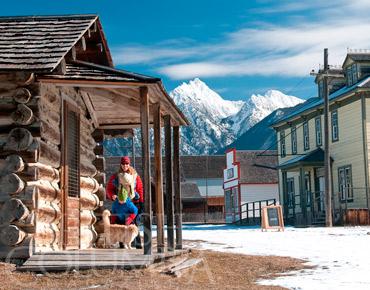
We’re late. Two snowsuit-clad boys rustle in the back seat. Our car barrels towards Fort Steele Heritage Town along Highway 93/95. Mount Fisher and the snow-capped peaks of The Steeples rise to the east, blotting out the blue sky, but my eye is on the clock. The restored gold-rush era town near Cranbrook has already been open for 10 minutes.
“I hope we can still get on a sleigh ride,” my wife frets. “You know how busy it gets.”
Shoulder-to-shoulder crowds are the norm during summer, as people line up for live theatre performances, gold panning, ice-cream making, and the ever-popular steam locomotive rides. We’ve never visited in winter before, but the promises of hot cocoa, bonfires, and Clydesdale-drawn sleigh rides have shaken away our lethargy this February weekend.
Minutes later we race into the parking lot—and find it empty. Completely empty. The entrance doors creak open, and we tiptoe into a darkened ticket office. “Hello?” I shout. Silence. Suddenly a head pops up from behind the counter. “Yes! We’re open!” a teenage boy adorned in turn-of-the-century britches— and nose piercing—smiles. Admission is by donation during winter. We toss a few bills into a glass jar. More silence. “Well, go on in,” the attendant finally motions towards the abandoned warren of streets and buildings lying beyond. Then he disappears beneath the counter once again.
Fort Steele, originally known as “Galbraith’s Ferry,” was founded in 1864 when gold was discovered on nearby Wild Horse Creek. Before long, it was home to 5,000 harness makers, blacksmiths, butchers, brewers, and miners and was the commercial hub of the region. But the town’s fortunes took an abrupt turn when Colonel James Baker persuaded the BC Southern Railway to bypass the burgeoning village in favour of empty fields he owned nearby. Within a decade Fort Steele had been abandoned. Not until 1961, when it was designated a provincial heritage site, did restoration begin.
In summer, a busy milieu of costumed townspeople and jostling tourists brings the gold-rush town alive; it’s a living, breathing museum. Now, we explore the restored structures—corrals, train station, waterwheel, bandstand, and churches—alone, at our own pace. The stillness is eerie at first, but quickly becomes refreshing. My four-year-old son clambers over historic farm equipment, pulling every lever he can find. We climb the stairs of a watchtower and look across the emerald waters of the Kootenay River. A cat jumps down from its perch on a cedar rail fence where it has been warming in the sun to purr and rub our legs. As the day wears on, only a handful of other visitors straggle in.
The weekend sleigh rides have been cancelled, due to a thick layer of ice on the ground, but that does not deter the boys, who stand and watch the horses through the fence for half an hour. Each steamy breath the horses take, lit by the late afternoon sun, is the size of a locomotive puff. A group of employees and their children playing shinny on an outdoor rink invite us to join in. They have extra sticks. After a few laps of the ice we are on our way. Naptime beckons. Before leaving we stop at the Candy Store. Outside, the parking lot—now with four vehicles—feels downright crammed.
Getting there
Fort Steele Heritage Town (250-417-6000; www.fortsteele.ca) lies on Highway 93/95, 15 minutes north of Cranbrook, and 1.5 hours south of Invermere in the southern Rockies.

